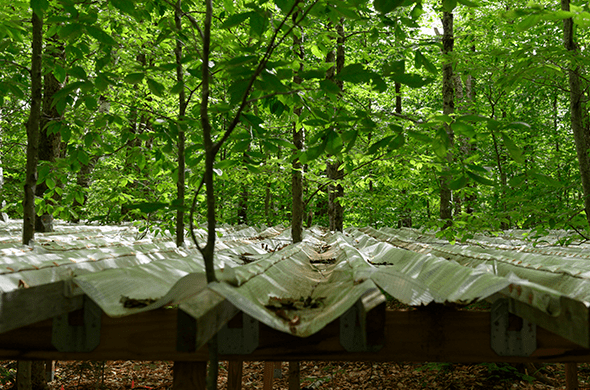DroughtNet
Project Overview
 While mean annual precipitation in the Northeastern U.S. is projected to increase modestly in the coming decades (especially in winter), it is expected to fall in fewer, more intense storms, with longer intervening dry periods. When combined with other changes in climate (i.e., less consistent snowpack, earlier snowmelt, and longer and hotter growing seasons), the altered precipitation regime may lead to a dramatic increase in growing season water stress in a region where species are not well adapted to drought. A throughfall removal experiment was initiated in 2015 to better understand the impacts of drought in mesic northern hardwood forests (Asbjornsen et al. 2018). A series of troughs covering 50% of the ground surface was installed above plots to simulate a 1st-percentile (100-year) drought based on the long-term meteorological record. After four years of treatment with little effect on most measured processes, the troughs were expanded to remove over 90% incoming precipitation in 2019. Ecosystem processes dependent on shallow soil moisture responded, but tree growth and tree water use did not, indicating that the study trees had roots outside the treatment plots that were sufficient to supply all their water demands. The throughfall removal structures were then removed prior to the 2020 growing season, and post-treatment monitoring is ongoing.
While mean annual precipitation in the Northeastern U.S. is projected to increase modestly in the coming decades (especially in winter), it is expected to fall in fewer, more intense storms, with longer intervening dry periods. When combined with other changes in climate (i.e., less consistent snowpack, earlier snowmelt, and longer and hotter growing seasons), the altered precipitation regime may lead to a dramatic increase in growing season water stress in a region where species are not well adapted to drought. A throughfall removal experiment was initiated in 2015 to better understand the impacts of drought in mesic northern hardwood forests (Asbjornsen et al. 2018). A series of troughs covering 50% of the ground surface was installed above plots to simulate a 1st-percentile (100-year) drought based on the long-term meteorological record. After four years of treatment with little effect on most measured processes, the troughs were expanded to remove over 90% incoming precipitation in 2019. Ecosystem processes dependent on shallow soil moisture responded, but tree growth and tree water use did not, indicating that the study trees had roots outside the treatment plots that were sufficient to supply all their water demands. The throughfall removal structures were then removed prior to the 2020 growing season, and post-treatment monitoring is ongoing.
Principal Investigators:
Graduate Students and Staff:
Asbjornsen, H., Campbell, J. L., Jennings, K. A., Vadeboncoeur, M. A., McIntire, C., Templer, P. H., Phillips, R. P., Bauerle, T. L., Dietze, M. C., Frey, S. D., Groffman, P. M., Guerrieri, R., Hanson, P. J., Kelsey, E. P., Knapp, A. K., McDowell, N. G., Meir, P., Novick, K. A., Ollinger, S. V., … Rustad, L. E. (2018). Guidelines and considerations for designing field experiments simulating precipitation extremes in forest ecosystems. Methods in Ecology and Evolution, 9(12), 2310–2325. https://doi.org/10.1111/2041-210X.13094
